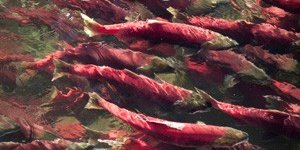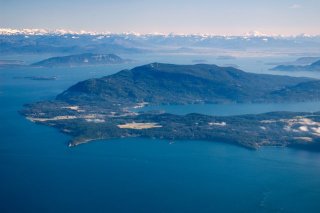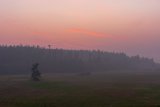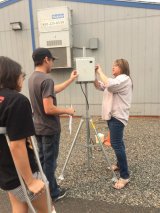EPA Research in Washington
EPA researchers are working hard to protect communities across the nation. Learn about some of the work EPA researchers are doing in Washington State.
- Modeling Floodplain and Restoration for Salmon Recovery in the Tolt River Watershed
- Studying Marine Ecosystems at the Ocean Basin Scale
- Reducing Nutrient Pollution in the Puget Sound
- Can Refuges Save Salmon from a Warming Climate?
- EPA Partners with Tribes to Deploy Air Sensors
- Assessing Impacts of Green Infrastructure on Groundwater Quality
- Chemical Safety Research Collaborators Provide Research Review
- Wildland Fire Sensors Challenge
- EPA Grants Fund Researchers Working with Communities to Monitor Air Pollution in Washington
- Upper Columbia River Contaminated Site
- Watershed Condition Improvements
- Microbial Treatment Targets for Water Reuse
For more EPA work, see EPA in Washington.
Modeling Floodplain and Restoration for Salmon Recovery in the Tolt River Watershed

After 10 years of collaborative research with the Snoqualmie Tribe, EPA recently published a report to guide salmon recovery efforts in the Puget Sound's Tolt River Watershed. The collaborative team leveraged the VELMA-Penumbra model, which can predict key indicators of a healthy salmon habitat, including stream flow and temperature. Read the Tolt Report (March 2025) in EPA's Science Inventory.
Studying Marine Ecosystems at the Ocean Basin Scale
Seagrasses, marine flowering plants that live in shallow waters and are critical to estuaries, have been experiencing worldwide degradation for decades. To better understand this issue, EPA’s Dr. Jim Kaldy collaborated with colleagues at the Chinese Academy of Sciences in Qingdao, China, on seagrass research. During the summer of 2017, researchers collected seagrass samples from five estuaries in Washington, three Oregon estuaries, and Humboldt Bay, California. This international collaboration has led to significant scientific advancements about these critical estuarine habitats. Read Studying Marine Ecosystems at the Ocean Basin Scale: Success Through Collaboration.
Reducing Nutrient Pollution in the Puget Sound

Excess nutrients flowing from the creeks, streams, and rivers of the surrounding watershed are a threat to water quality and aquatic resources in Puget Sound. EPA researchers in the Office of Research and Development collaborate with regional, local, and state partners to develop strategies for identifying and reducing the sources of nitrogen. EPA researchers are also supporting the development of a comprehensive, scientifically-backed approach that considers and informs environmental planning and decision making across the sprawling Puget Sound watershed. Learn more about this work in Puget Sound.
Can Refuges Save Salmon from a Warming Climate?
Salmon are a defining feature of the Pacific Northwest (PNW) region along North America’s Pacific coast, providing an important cornerstone of PNW culture, economy, and ecology but that role is threatened by climate change. EPA researchers studied the effects of cold-water refuges on migrating salmon in the Columbia River Basin. Read Tough Places and Safe Spaces: Can Refuges Save Salmon from a Warming Climate?.
EPA Partners with Tribes to Deploy Air Sensors

Air quality is a primary concern for many PNW Tribal communities. EPA's Office of Research and Development is working with Tribal communities to deploy air sensors to help people learn about air quality issues in their communities. The partnership between EPA scientists and the Nez Perce Tribe, Heritage University (located on the Yakama Reservation in Washington), and the Institute of Tribal Environmental Professionals (ITEP) increased the availability of low-cost air sensors for tribal community use. Read EPA Partners with Tribes to Deploy Air Sensors in Communities.
Assessing Impacts of Green Infrastructure on Groundwater Quality
Green infrastructure reduces stress on wastewater systems, decreases sewer overflows, and improves watershed health—but how does it impact groundwater quality? EPA completed a comprehensive multi-year study to find out. Researchers intensively monitored three locations with established green infrastructure systems that are also diverse in climate, geology, and geography, including Yakima, Washington. The data collected can be used by state and local agencies to make decisions about implementing green infrastructure in their communities. Read Assessing Impacts of Green Infrastructure on Groundwater Quality.
Chemical Safety Research Collaborators Provide Research Review
EPA is working with grantees to develop predictive toxicology tools. This work includes research on virtual tissue models, sometimes referred to as “Organs on-a-chip,” provide a pathway for the development of new prediction techniques. They also have the potential to reduce dependence on animal study data and contribute to faster chemical risk assessments. To highlight research progress and share information, EPA hosted their 3rd Annual STAR Organotypic Culture Models for Predictive Toxicology Research Centers Progress Review in May 2018. The two-day conference enabled robust discussion between interdisciplinary scientists and trainees within EPA and at institutions, including the University of Washington. Read Developing Organs On-a-Chip: Chemical Safety Research Collaborators Provide Research Review.
Wildland Fire Sensors Challenge
Wildland fires pose many obstacles for air quality monitoring because of high concentrations of air pollutants, high temperatures, rugged terrain, and other challenges. EPA and partners created the Wildland Fire Sensors Challenge to develop air monitoring instruments that could handle these conditions. In Bellevue, Washington, a former volunteer firefighter and a developer of environmental measurement systems for the Americas Cup in Australia earned second place in the Sensors Challenge with a $25,000 prize. Read Wildland Fire Sensors Challenge: Winners Provide Real-time Systems for Measuring Pollutant Levels from Smoke.

EPA's Grant for Researchers Monitoring Air Pollution in Washington
EPA grantees are working in cities across the country to teach local residents about how to use low-cost air pollution sensors to monitor air quality. One grantee worked with a team to teach local students how to use low-cost air pollution sensors to monitor air quality in Washington’s lower Yakima Valley. Read EPA Grants Fund Researchers Working with Communities to Monitor Air Pollution in Washington and Pennsylvania.
Upper Columbia River Contaminated Site
EPA Office of Research and Development (ORD), in coordination with Region 10, is providing technical support for the Upper Columbia River (UCR) Valley Superfund Site’s remedial investigation/feasibility study. ORD is a member of the UCR Soil Amendment Technologies Evaluation Study technical team established through the interaction of the Coleville Confederated Tribes, Washington State Department of Ecology, Teck Resources Limited, Ramboll Environ and EPA Region 10.
Watershed Condition Improvements
EPA ORD has developed and transferred modeling tools to Nisqually Community Forest (NCF) to support their salmon-recovery planning in the Mashel River watershed, a once prime salmon producing sub-basin of the Nisqually River. NCF staff are currently using EPA’s Visualizing Ecosystem Land Management Assessments (VELMA) watershed simulator to quantify long-term effects of alternative management and climate scenarios on key salmon habitat and water quality variables.
Microbial Treatment Targets for Water Reuse
In January 2025, ORD, in collaboration with the Office of Water’s Water Reuse Program, published the scientific report Risk-Based Framework for Developing Microbial Treatment Targets for Water Reuse. This peer-reviewed EPA resource outlines a modeling process that states and other jurisdictions can utilize to develop scientifically defensible water reuse treatment targets and provides state-of-the-science parameter input values. Washington is among the first states to directly utilize the new reference, using its disability-adjusted life year (DALY)-based targets in their draft proposal for onsite non-potable use to provide a firm and defensible technical basis to inform their proposed rules. Read the EPA Research Partner Support Story: Microbial Treatment Targets for Water Reuse.
